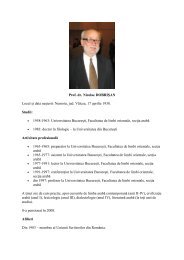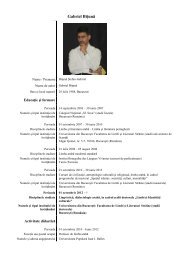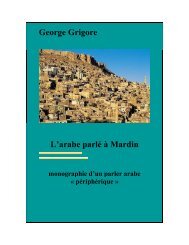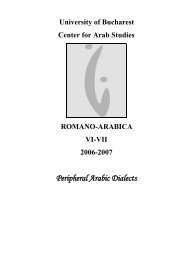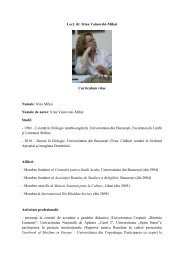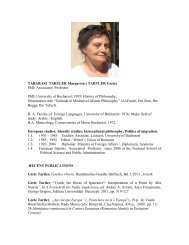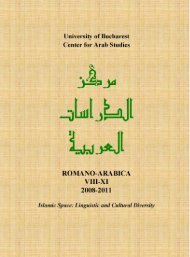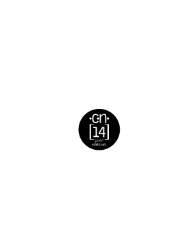12 55 Years of Arab Studies in Romania - Secţia de Arabă
12 55 Years of Arab Studies in Romania - Secţia de Arabă
12 55 Years of Arab Studies in Romania - Secţia de Arabă
You also want an ePaper? Increase the reach of your titles
YUMPU automatically turns print PDFs into web optimized ePapers that Google loves.
SOME ASPECTS OF NEGATION IN THE LEBANESE SERIES 'AJYĀL<br />
Iulia Anamaria Alexandru<br />
University <strong>of</strong> Bucharest<br />
Abstract. The Lebanese dialect has certa<strong>in</strong> regional particularities, especially <strong>in</strong> what regards the<br />
pronunciation and grammar. The negation can be a tricky matter, as the ways <strong>of</strong> express<strong>in</strong>g it <strong>in</strong><br />
the spoken dialects are very different than the forms we might encounter <strong>in</strong> more elevated forms <strong>of</strong><br />
<strong>Arab</strong>ic. Along with a brief <strong>de</strong>scription <strong>of</strong> what we call the Lebanese dialect, the purpose <strong>of</strong> this<br />
paper is to present some aspects <strong>of</strong> the Lebanese negation as it appears <strong>in</strong> the consulted works,<br />
which will then be compared <strong>in</strong> the second part <strong>of</strong> our study with our remarks on the negation<br />
based on a Lebanese series, and f<strong>in</strong>ally <strong>in</strong> a third part we will compare the results <strong>of</strong> our research<br />
with the ways <strong>of</strong> ren<strong>de</strong>r<strong>in</strong>g the negation used by a native Lebanese speaker.<br />
Keywords: lebanese, dialect, negation, Bizri, Feghali, el-Hajje, particles.<br />
1. Foreword<br />
The Lebanese dialect, along with the Syrian, Palest<strong>in</strong>ian, Jordanian<br />
dialects belong to the so called oriental dialects. Fida Bizri goes beyond by say<strong>in</strong>g<br />
that it’s actually “the same language”, with small differences based on the region<br />
or the environment where it’s actually be<strong>in</strong>g talked and she calls this language<br />
Levant<strong>in</strong>e <strong>Arab</strong>ic. She goes on expla<strong>in</strong><strong>in</strong>g that this dialectal family first appeared<br />
as a consequence <strong>of</strong> the contact between the <strong>Arab</strong>ic dialect <strong>in</strong>troduced by the<br />
Muslim conquerors <strong>in</strong> the 7 th century and between the Syriac language 1 , which<br />
was spoken <strong>in</strong> the moment <strong>of</strong> the Muslim conquest <strong>in</strong> the region <strong>of</strong> the Levant.<br />
Subsequently, these dialects have cont<strong>in</strong>ued to evolve, especially regard<strong>in</strong>g the<br />
vocabulary, un<strong>de</strong>r the <strong>in</strong>fluence <strong>of</strong> Persian, Italian, Turkish, but also French and<br />
English. (Bizri, 2010: 15)<br />
In his turn, Hassan el-Hajje po<strong>in</strong>ts out that the dialects belong<strong>in</strong>g to the<br />
Levant<strong>in</strong>e <strong>Arab</strong>ic have certa<strong>in</strong> similarities. Among these similarities, some <strong>of</strong> the<br />
most spectacular rema<strong>in</strong> the pronunciation <strong>of</strong> the voiceless unaspirated uvular<br />
consonant qaf as a glottal stop, the <strong>de</strong>crease <strong>in</strong> <strong>in</strong>tensity <strong>of</strong> h, that may lead to its<br />
1<br />
The <strong>in</strong>fluence <strong>of</strong> the Syriac language on the Lebanese dialect is still strong today, especially<br />
regard<strong>in</strong>g the pronunciation and the grammar. Furthermore, certa<strong>in</strong> <strong>de</strong>velopments <strong>of</strong> the Syriac<br />
language can still be heard <strong>in</strong> some Syrian or Lebanese villages, among the communities that still<br />
follow the Syriac rite, but also <strong>in</strong> the Maronite community, for which the Syriac represent a sacred<br />
language. (Bizri, 2010: 15)<br />
17



